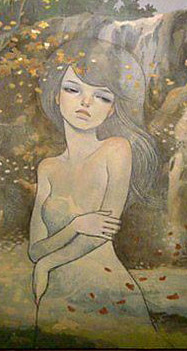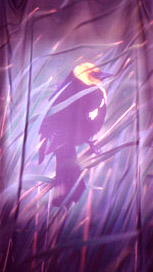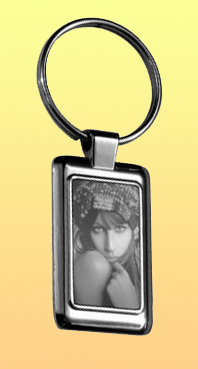
Photo on wood

Photo on fabric

Photo on metal
To prepare the solution to enables you to make photo on fabric, on skin, or photo on wood you need to prepare: citrate ammonium ferro - 85 g, tartaric acid, 14 g, silver nitrate - 35 g and water -1 l. Prepare the solution as follows: first substances citrate ammonium ferro and tartaric acid are dissolved separately in a little water, and then both solutions mixed, then silver nitrate added, and well stirred with a glass rod and then diluted with 1 liter of water. This solution should only be kept in a dark glass container in a dark place (without light)!
The selected material (wood, fabric or leather) are immersed into the solution and allowed to dry in the dark place! If you apply photo on fabric or the skin - this material, which is applied to the picture, stretched on a frame. Next, the dry material should make an imprint with normal or contrast negatives lit in daylight or artificial light, and then for 1 minute fabric or the skin, where applied photo, washed with water. The image is yellowish color, then it gradually turns into brown, if it is allowed to dry in the daylight, and then fixed with a normal fixer. During operation of the fixer on the photo the image is lightened, so if you want to get not too bright (light) photo on fabric or leather, you need to make the print darker than you want.
Photo on wood
Let is consider, when applying photo on wood.
We need to prepare the whipped egg albumen from 2 eggs and leave it for 1...2 h, while albumin is liquid. Then you should add zinc oxide befor a liquid suspension. This mixture is applied in a uniform layer on a wooden surface. After drying make the fill the surface with silver nitrate (silver nitrate solution of 1.6 g per 15 ml of water). To dry in a dark place. Imprint do with negativity in daylight, fixed with 5% sodium thiosulfate solution, then washed with water and dried.
Photo on fabric
To make the photos on fabric, it will first need to wash in warm water with soap, rinse and dry, then apply a photosensitive solution. Work of course is necessary in low light, as the solution is highly sensitive to light!
The solution is prepared so:
1 solution: Oxalic acid - 3.5 g and water - 50ml (water temperature - 60 0C).
2 solution: Sulfate ammonium ferro - 5 g, water to 50 ml.
Both solutions were decanted and after cooling, add 20...25 ml of 15% ammonia solution. When you add ammonia you must continuously stirring the solution with a glass rod. The fabric is immersed into the solution and after soaking remove, slightly wring out. Allow to dry at room temperature, pre-pulling the fabric onto the frame. When the fabric is dry, it needs to be ironed with a hot iron.
Photo on fabric is applied as follows: put the negative emulsion layer down in the well-stretched fabric. Exhibit a strong light source. The exposure time is determined empirically.
The fabric overexposed pull on the frame again and dip it in a developing solutionon on 3...4 sec., that is comprising ammonium nitrate (solution of ammonium nitrate - 3 g, silver nitrate - 1 g, water - 100 ml). The result is a black-white image. Then the fabric squeeze and immersed in a 0.1% solution for about 1 minute hydrochloric acid, washed with water and 2...3 minutes immersed in the fixer - a 1% solution of hyposulphite. Washed with water and dried again, and then use hot iron. After ironing the image acquires firmness and matte black color.
Here's a reaction process: when oxalic acid in excess, copper-ammonium alum form a complex compound, which has the ability to recover under the action of light, forming a salt of bivalent iron. Depending on the light the different number of ions are ironformed: the more light, the more iron ions. When processing with silver nitrate solution tyhe latent image is manifested. This is because iron ions restore the silver nitrate to metal - silver.
Photo on metal
Let is consider how you can get photo on metal, for example, on an aluminum plate. Anodized aluminum plate dipped in a 10% solution of potassium bromide for 20 minutes and then dried. Then the plate is treated with a 10% solution of silver nitrate in red light plate for 15 minutes, the image exposed on it (as on photo paper), then in the developer and fixer (as usual bromine photo paper). Dried photo cover discolored nitrocellulose lacquer.
Obtaining silhouette chemically
How to get artistic image from photo
Many believe that the more accurate the pictures show the reality, the better! But not always! People which do the photo, should not give the "structure" of the object and its image, but should give the shadow and the relationship to other objects in the photo.
Let's consider some ways to get artistic photos using chemical materials.
Photo silhouette is a photographic print that has no shadows and mid-tones, but there are black and white tones. Any negative can be translated in photo silhouette with multiple contact copying of highly contrasting paper.
The negative contact copy on documentary film. From the resulting slide doing the double negative that more contrast of the original. If repeat this operation many times (at least 3...4 times), it turns out the negativity without shadows and midtones. When copy it on a contrasting paper will photo silhouette.
Shadows and mid-tones on the negative can be removed by chemical means, using the following solutions:
1) sodium thiosulfate - 100 g, water - 1 liter;
2) red blood salt - 20 g, water - 200 ml.
A common solution is prepared, merging solution of 1) and 2) in one with ratio of 4:1. It is important that the solution was prepared immediately prior to use. The negative need to be immersed in the solution at a temperature of 20 0C and monitored. When the light spots will disappear, then the process is completed. Then the negative should be washed thoroughly in water.
Crystal growing. How to grow crystal
Color glass. The crystal. Quartz glass
Complex substances. Water hardness
The density of substances (materials)
Color of gold. Alloys of gold. Stamp of gold
Structure of paint
Mineral paint
Chemistry tasks. Solve simple! Examples
Removal of corrosion with different metals
Polycondensation, polyester, nylon, capron
Toilet soap. Making soap at home
Food additives, conserving agents
Varnishes. Solvents of varnishes
Getting acetate silk. Getting viscose